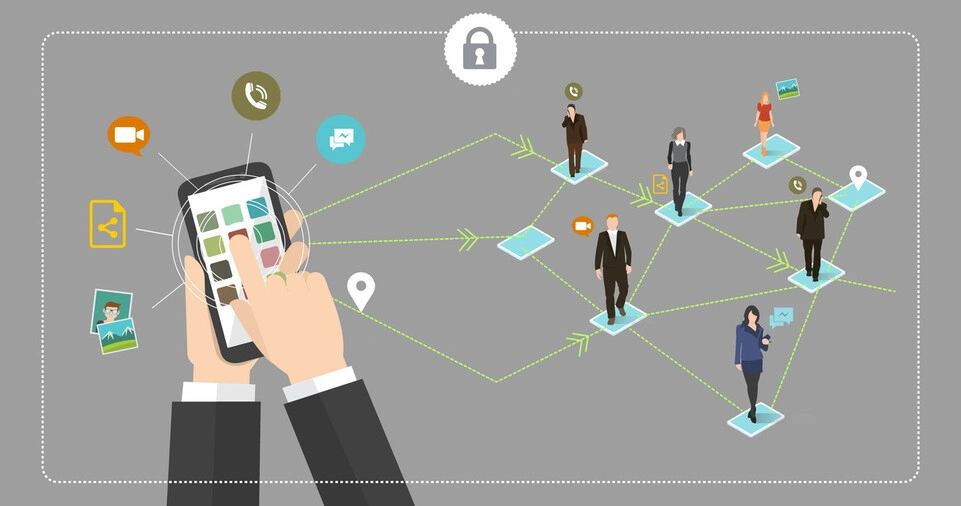In today’s fast-paced work environment, effective communication is essential for success.
Real-time messaging has become a cornerstone of workplace communication, especially with the rise of remote and hybrid teams.
It allows colleagues to instantly exchange ideas, resolve issues, and keep each other updated without the delays associated with emails or in-person meetings.
However, while real-time messaging can greatly improve workplace efficiency, it can also lead to information overload, miscommunication, and a lack of focus if not properly managed.
In this guide, we will explore how to enhance real-time messaging in workplaces, offering strategies for improving communication, boosting team collaboration, and reducing common challenges.
From choosing the right messaging platform to implementing guidelines for efficient communication, these tips can help streamline your workplace’s messaging system.
By optimizing your messaging workflows, you can not only improve communication but also increase productivity and foster a positive, collaborative work culture.
The Importance of Real-Time Messaging in the Workplace
Real-time messaging has revolutionized the way teams communicate. It breaks down geographical barriers, supports faster decision-making, and fosters collaboration.
Employees can now share ideas, give feedback, and coordinate tasks immediately.
Unlike traditional emails or meetings, real-time messaging platforms facilitate quick exchanges and help avoid the delays caused by waiting for a response.
This real-time exchange can enhance productivity, foster transparency, and provide teams with an immediate way to solve problems and discuss issues as they arise.
However, the power of real-time messaging can only be harnessed effectively if the system is structured properly.
Without the right approach, it can lead to miscommunication, missed messages, or distractions that reduce overall productivity.
Choosing the Right Messaging Platform for Your Workplace
Assess Your Team’s Needs
The first step to enhancing real-time messaging is selecting the right platform. Several messaging tools are available today, each offering different features and capabilities.
Some popular options include Slack, Microsoft Teams, and Google Chat.
Each platform has its strengths and weaknesses, so understanding your team’s needs is crucial in choosing the most appropriate solution.
Key Features to Look for:
Ease of Use:
A user-friendly interface is essential to encourage adoption. Platforms with intuitive designs and easy navigation help employees quickly get up to speed, regardless of their tech-savviness.
Integration with Other Tools:
A good messaging platform should seamlessly integrate with other tools your team uses, such as file-sharing services, project management systems, and calendar apps. This ensures a smooth workflow and reduces the need for switching between multiple apps.
Security and Privacy:
Make sure the platform offers robust security features, especially if your team deals with sensitive or confidential information. Features like end-to-end encryption and access controls should be a priority.
Customization and Scalability:
Your chosen platform should be customizable to fit the unique needs of your team. Additionally, it should be scalable to accommodate your organization’s growth and evolving communication needs.
Popular Messaging Platforms:
Slack:
Known for its easy-to-use interface and numerous integrations, Slack is ideal for organizations that require a wide range of collaboration tools, such as file sharing, notifications, and custom channels.
Microsoft Teams:
Perfect for teams already using Office 365, Teams integrates well with Microsoft’s suite of tools, making it a seamless option for businesses reliant on Word, Excel, and PowerPoint.
Google Chat:
Ideal for teams using Google Workspace, Google Chat offers simple communication with the ability to collaborate on Google Docs, Sheets, and Slides in real time.
Set Clear Communication Guidelines
One of the biggest challenges in using real-time messaging effectively is managing how and when it should be used.
Without proper guidelines, employees may feel overwhelmed by the constant flow of messages, or they may misuse the platform for non-urgent matters.
Establishing Best Practices
Define Urgency Levels:
Clearly outline when to use messaging for urgent communication and when email or other methods may be more appropriate.
For instance, use messaging for quick updates, clarifications, or immediate concerns, while reserving email for more formal or detailed communication.
Use Channels Effectively:
Grouping messages into channels based on topics, teams, or projects helps prevent information overload.
Each channel should serve a distinct purpose, such as project updates, team discussions, or company-wide announcements. This organization makes it easier to find important information.
Set Response Expectations:
While real-time messaging encourages quick replies, it’s important to set realistic expectations for response times.
Not all messages need immediate responses, and employees should be allowed focused work time without the pressure of responding to every ping right away.
Avoid Overuse of Direct Messages:
Direct messages are useful for private conversations, but they can quickly become overwhelming when overused.
Encourage employees to use direct messages sparingly and prioritize public channels for discussions that could benefit the whole team.
Communicate the Guidelines Clearly
Ensure that all employees understand the rules and expectations surrounding real-time messaging.
This can be done through training sessions, employee handbooks, or team discussions.
By setting clear expectations, you’ll prevent confusion and help everyone communicate more effectively.
Implement Channels and Group Chats for Better Organization

The Power of Channels
One of the key benefits of real-time messaging platforms is the ability to create dedicated channels for different topics, teams, or projects.
These channels help organize conversations and prevent them from getting lost in a sea of irrelevant messages.
Team-specific Channels:
Create channels for each department or team (e.g., Sales, Marketing, HR) to ensure that relevant information is only shared with the people who need it. This helps reduce noise and keeps everyone focused on their specific tasks.
Project-based Channels:
For each project, set up a dedicated channel where team members can collaborate, share updates, ask questions, and track progress.
This creates a central hub for all communication related to a specific project and avoids the need for endless email chains.
Company-wide Channels:
Use company-wide channels for important announcements, general discussions, and social interactions. This ensures that everyone in the organization stays informed and engaged.
Topic-specific Channels:
Consider creating channels for common topics or themes, such as “tech-support,” “client-queries,” or “general-questions,” to give employees a space to seek help or share ideas without crowding other channels.
Benefits of Organized Channels
Organizing your messaging system with clear channels improves communication by reducing confusion and allowing team members to stay up to date with the latest developments in their relevant areas.
It also helps to reduce unnecessary distractions by limiting access to only the channels relevant to each person’s role.
Leverage Automation and Bots to Streamline Communication
The Role of Bots in Real-Time Messaging
Automation is a great way to enhance productivity and reduce manual tasks that can bog down communication.
Messaging platforms like Slack and Microsoft Teams offer bots and automation tools that can handle repetitive tasks and manage workflows.
Task Reminders:
Bots can send automatic reminders about upcoming deadlines, meetings, or tasks. This ensures that important deadlines don’t slip through the cracks and that everyone stays on track.
FAQs and Knowledge Base:
Bots can be programmed to answer common questions or direct team members to a knowledge base for self-service help.
This reduces the load on human support staff and allows employees to get the information they need quickly.
Workflow Automation:
Bots can also automate processes like onboarding, reporting, or document sharing.
For example, an onboarding bot can provide new employees with a checklist of tasks, while a reporting bot can automatically generate and share weekly performance reports.
Integrating Third-Party Tools
You can also integrate third-party automation tools like Zapier or Integromat with your messaging platform.
This can help automate tasks like updating project management tools, syncing calendar events, or sending notifications across different apps.
Use Notifications Wisely to Avoid Overload

Managing Notification Settings
Real-time messaging can become a source of distraction if employees are constantly interrupted by notifications.
To prevent burnout, it’s important to manage notification settings effectively.
Customizing Notifications:
Allow employees to customize notifications so they only receive alerts for the most relevant messages.
This prevents distractions from less important messages and ensures that employees can focus on deep work without constant interruptions.
Prioritize Important Alerts:
Set up priority settings for messages that require immediate attention, such as messages from supervisors, urgent team requests, or high-priority clients.
Mute Non-Urgent Channels:
Encourage employees to mute channels that are not essential to their daily work, like social or non-work-related discussions. This helps reduce notification fatigue and ensures that they only see messages that matter.
Foster a Culture of Responsiveness
Promoting Timely Responses
While real-time messaging encourages quick replies, it’s important to establish a balanced approach to responsiveness.
Employees should be encouraged to reply promptly to urgent messages but also be allowed uninterrupted time to focus on deep work.
Setting Expectations for Response Times
Set expectations for how quickly team members should respond to different types of messages.
For example, urgent issues might require responses within an hour, while non-urgent requests can be addressed within 24 hours.
This helps everyone manage their time effectively and keeps communication flowing smoothly.
Provide Training on Effective Messaging Etiquette
Teaching Clear and Concise Communication
To avoid misunderstandings and confusion, employees should be trained in effective messaging etiquette.
This includes writing clear and concise messages, using appropriate tone and language, and structuring messages for clarity.
Be Direct and Specific:
Avoid vague messages and get straight to the point. Instead of saying “Can you help with this?” say, “I need help with the quarterly report; can you review the data section?”
Use Emojis and Reactions Appropriately:
Encourage employees to use emojis or reactions to indicate acknowledgment or appreciation, but make sure they don’t overuse them in formal conversations.
Be Professional:
Even though messaging is casual, maintaining professionalism is important, especially in a business context. Remind employees to maintain respect and clarity in their conversations.
Monitor and Adjust Communication Practices Based on Feedback
Continuous Improvement
To ensure that your real-time messaging system is effective, regularly collect feedback from employees. Ask them about their experiences, challenges, and suggestions for improvement.
By continuously evaluating and adjusting your communication practices, you can ensure that your messaging system remains efficient and beneficial for everyone involved.
ALSO READ: How to Build Stronger Connections Through Online Communication Tools
Conclusion
Real-time messaging can be a powerful tool to enhance communication, collaboration, and productivity in the workplace.
By choosing the right platform, setting clear guidelines, organizing channels, and leveraging automation, you can create a messaging system that benefits everyone in your organization.
With these strategies, you can foster a more productive and collaborative work environment, making your workplace more connected and effective than ever before.







